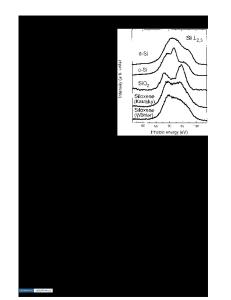Glass Formation and Local Topological Instability of Atomic Structure
- PDF / 377,661 Bytes
- 8 Pages / 414.72 x 648 pts Page_size
- 36 Downloads / 593 Views
T. EGAMI Department of Materials Science and Engineering, University of Pennsylvania, Philadelphia, PA 19104-6272
ABSTRACT A direct connection between the local topology of the atomic structure of liquids and glasses and thermodynamic quantities through the atomic level stresses is suggested for metallic alloys. In particular the role of local topological instability in the phase transformations involving liquid and glass will be discussed. It is pointed out that a single local geometrical criterion can explain various phase transformations, such as melting, glass transition, and glass formation by solid state reaction and liquid quenching.
1. INTRODUCTION One of the main difficulties in formulating theories of a glassy and liquid state is that it is not easy to describe the atomic structures of glasses and liquids with sufficient accuracy. In particular in order to elucidate subtle phenomena such as glass transition and structural relaxation one has to know the temperature dependence of the structure of the glass and liquid state, while even the proper choice of an order parameter is unclear. The purpose of this paper is to advance the view that the topological description of local atomic structure can be used as a basis for a sta-
tistical theory of metallic glasses and liquids, when it is used in conjunction with the idea of atomic level stresses. Topological description of local atomic structure has been widely used in characterizing both the continuous random network (CRN) structure and the dense random packed (DRP) structure [1]. However it is usually not possible to find direct links between the topological parameters and thermodynamic quantities. On the other hand in metallic glasses such a link may be established by deploying the concept of atomic level stresses [2,3]. In this paper we review this connection, and discuss how it will lead to the local topological instability criterion recently proposed as a universal criterion for metallic glass formation that semi-quantitatively explains melting of crystalline metals, glass transition, solid state amorphization as well as glass formation by liquid quenching from an atomistic point of view [4,5].
2. DESCRIPTION OF THE LOCAL STRUCTURE The basis for a topological description of the atomic structure is the definition of the atomic connectivity network. This can be done readily for covalently bonded solids such as oxide glasses, while for metallic solids the definition is less clear. However, the presence of a well defined first peak in the pair-density function (PDF) with a deep minimum before the second 397 Mat. Res. Soc. Symp. Proc. Vol. 455 0 1997 Materials Research Society
peak is sufficient to define the atomic connectivity by metallic bonding. Once the topology of the structure is established local geometry has to be introduced in order to make a connection to the energy, since even for the same topology the energy is dependent on the local distortion of the structure. However, it is not easy to determine the local strain, since in order to define
Data Loading...











